Intel Core i7 3960X (Sandy Bridge E) Review: Keeping the High End Alive
by Anand Lal Shimpi on November 14, 2011 3:01 AM EST- Posted in
- CPUs
- Intel
- Core i7
- Sandy Bridge
- Sandy Bridge E
Windows 7 Application Performance
3dsmax 9
Today's desktop processors are more than fast enough to do professional level 3D rendering at home. To look at performance under 3dsmax we ran the SPECapc 3dsmax 8 benchmark (only the CPU rendering tests) under 3dsmax 9 SP1. The results reported are the rendering composite scores.
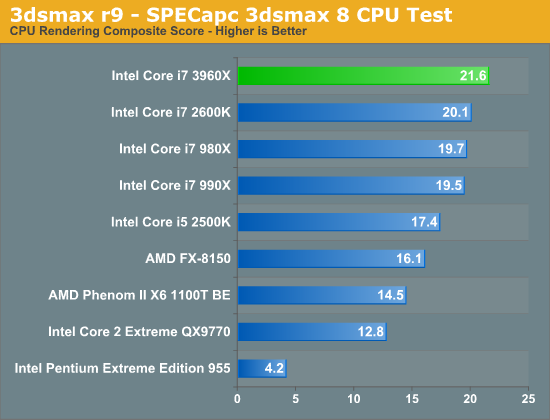
Offline 3D rendering applications make some of the best use of CPU cores, unfortunately our test here doesn't scale all that well. We only see a 7% increase over the 2600K. If we look at a more modern 3D workload however...
Cinebench 11.5
Created by the Cinema 4D folks we have Cinebench, a popular 3D rendering benchmark that gives us both single and multi-threaded 3D rendering results.
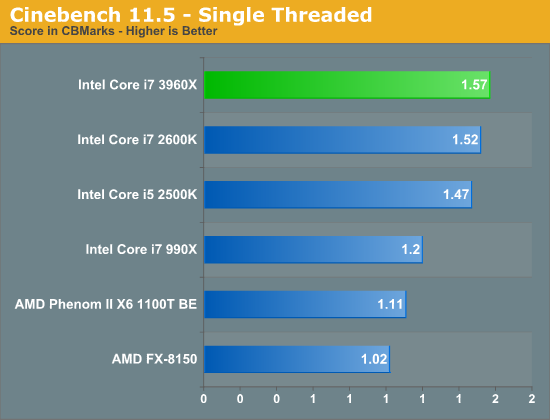
Single threaded performance is marginally better than the 2600K thanks to the 3960X's slightly higher max turbo speed. What's more important than the performance here is the fact that the 3960X is able to properly power gate all idle cores and give a single core full reign of the chip's TDP. Turbo is alive and well in SNB-E, just as it was in Sandy Bridge.
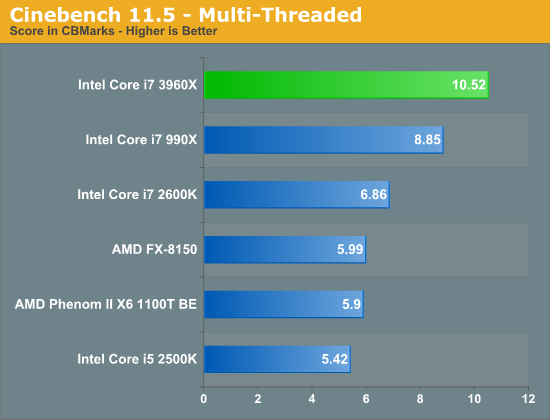
Here the performance gains are staggering. The 3960X is 53% faster than the 2600K and 19% faster than Intel's previous 6-core flagship, the 990X. The Bulldozer comparison is almost unfair, the 3960X is 75% faster (granted it is also multiple times the price of the FX-8150).
7-Zip Benchmark
While Cinebench shows us multithreaded floating point performance, the 7-zip benchmark gives us an indication of multithreaded integer performance:

Here we see huge gains over the 2600K (58%), indicating that the increase in cache size and memory bandwidth help the boost in core count a bit here. The advantage over the 990X is only 7%. This gives us a bit of a preview of what we can expect from SNB-EP Xeon server performance.
PAR2 Benchmark
Par2 is an application used for reconstructing downloaded archives. It can generate parity data from a given archive and later use it to recover the archive
Chuchusoft took the source code of par2cmdline 0.4 and parallelized it using Intel’s Threading Building Blocks 2.1. The result is a version of par2cmdline that can spawn multiple threads to repair par2 archives. For this test we took a 708MB archive, corrupted nearly 60MB of it, and used the multithreaded par2cmdline to recover it. The scores reported are the repair and recover time in seconds.
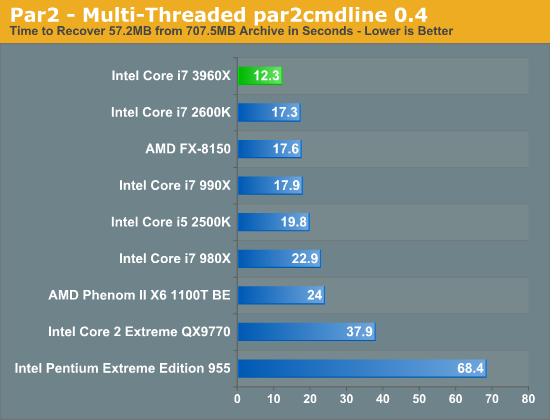
Here we see a 40% increase in performance over the 2600K and FX-8150.
TrueCrypt Benchmark
TrueCrypt is a very popular encryption package that offers full AES-NI support. The application also features a built-in encryption benchmark that we can use to measure CPU performance with:
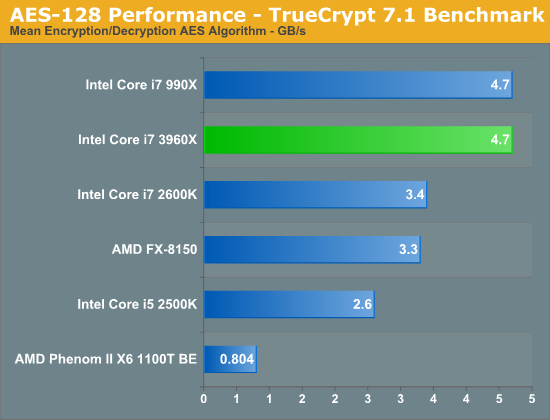
As both the 990X and 3960X have AES-NI support, both are equally capable at cranking through an AES workload. Per core performance doesn't appear to have changed all that much with the move to Sandy Bridge, so here we have a situation where the 3960X is much faster than the 2600K but no faster than the 990X. I suspect these types of scenarios will be fairly rare.
x264 HD 3.03 Benchmark
Graysky's x264 HD test uses x264 to encode a 4Mbps 720p MPEG-2 source. The focus here is on quality rather than speed, thus the benchmark uses a 2-pass encode and reports the average frame rate in each pass.
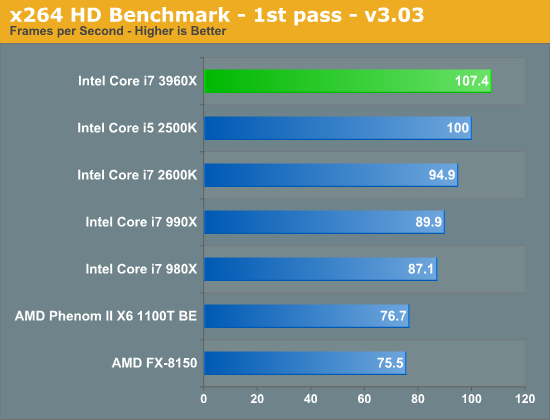
Single threaded performance isn't significantly faster than your run-of-the-mill Sandy Bridge, which means the first x264 HD pass doesn't look all that impressive on SNB-E.
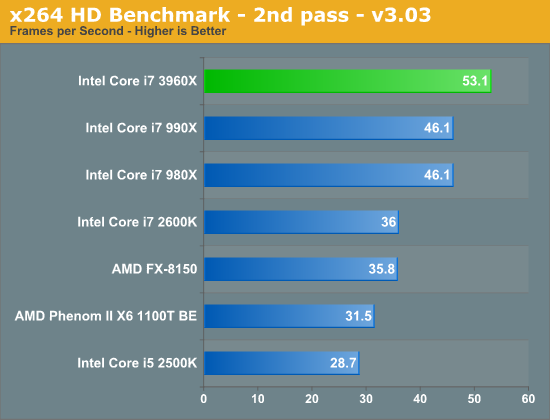
The second pass however stresses all six cores far more readily, resulting in a 47.5% increase in performance over the 2600K. Even compared to the 990X there's a 15% increase in performance.
Adobe Photoshop CS4
To measure performance under Photoshop CS4 we turn to the Retouch Artists’ Speed Test. The test does basic photo editing; there are a couple of color space conversions, many layer creations, color curve adjustment, image and canvas size adjustment, unsharp mask, and finally a gaussian blur performed on the entire image.
The whole process is timed and thanks to the use of Intel's X25-M SSD as our test bed hard drive, performance is far more predictable than back when we used to test on mechanical disks.
Time is reported in seconds and the lower numbers mean better performance. The test is multithreaded and can hit all four cores in a quad-core machine.
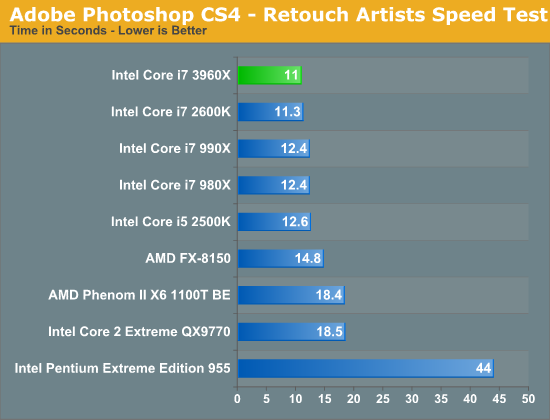
Our Photoshop test is multithreaded but there are only spikes that use more than four cores. That combined with the short duration of the benchmark shows no real advantage to the 3960X over the 2600K. Sandy Bridge E is faster than Intel's old 6-core solution though.
Compile Chromium Test
You guys asked for it and finally I have something I feel is a good software build test. Using Visual Studio 2008 I'm compiling Chromium. It's a pretty huge project that takes over forty minutes to compile from the command line on the Core i3 2100. But the results are repeatable and the compile process will stress all 12 threads at 100% for almost the entire time on a 980X so it works for me.
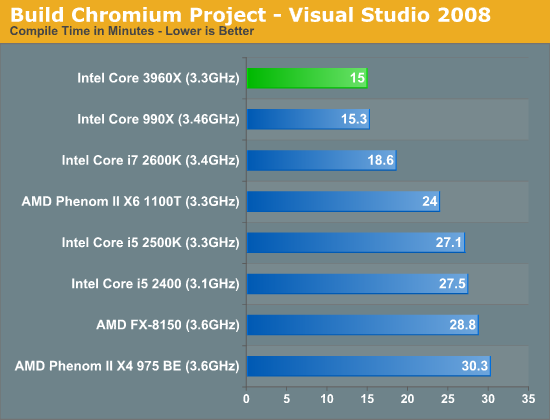
Our compile test is extremely well threaded, which once again does well on the 3960X. The gains aren't as big as what we saw in some of our earlier 3D/transcoding tests, but if you're looking to build the fastest development workstation you'll want a Sandy Bridge E.
Excel Monte Carlo
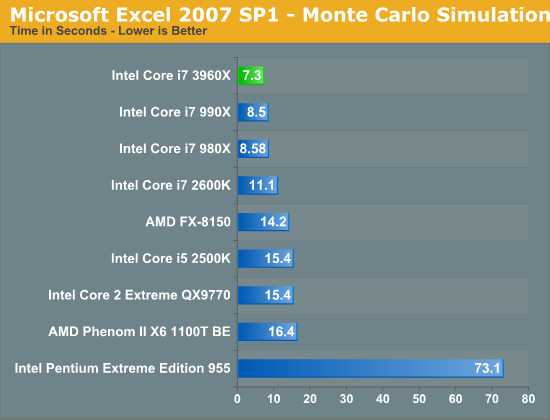
Multithreaded compute does well on SNB-E regardless of the type of application. Excel is multithreaded and if you have a beefy enough workload, you'll see huge gains over the 2600K.










163 Comments
View All Comments
yankeeDDL - Monday, November 14, 2011 - link
That's what I was doing: blaming AMD. Intel is doing what any company that is interested in making money/profit would do.yankeeDDL - Monday, November 14, 2011 - link
Sorry ... I replied to the wrong post :) I meant to hit the one below!JlHADJOE - Tuesday, November 15, 2011 - link
If you compare it to the extreme edition chip, then Bulldozer looks like good value. But then the 3960X is a halo model for those people who care nothing about price.Considering the 3930K gives you 95% the performance of the 3960X for 50% of the price (see xbitlabs), there's really no reason to get the X-edition chip unless you are building a system purely for bragging rights.
Now when compared to the 3930K, the FX8150 doesn't look nearly as good. If we consider total platform costs with either system having a $300 motherboard and $200 in ram, then we're looking at something in the region of $750 for BD, vs $1000 for the SB-E. +$250 is small change for double the performance at a similar power envelope.
yankeeDDL - Tuesday, November 15, 2011 - link
JIHADJOE, yes, that was my point.The 3960X is -arguably- the fastest CPU available, but it is faster by a tiny margin, while being radically more expensive than anything else.
So yes, nothing looks as bad in terms of price/performance ratio, not even the FX8150. And that's, basically, bad for everyone (except Intel)
actionjksn - Monday, November 14, 2011 - link
I agree too AMD's poor Bulldozer performance is having a huge effect on what we can get from Intel and at what price. And I blame AMD not Intel, because Intel or any other company is supposed to do what's best for their company. Heck if Intel did what we want they would probably cause serious harm to AMD. Because it would make AMD even less competitive. And I don't think Intel really wants to put AMD out of business.yankeeDDL - Monday, November 14, 2011 - link
That's what I was doing: blaming AMD. Intel is doing what any company that is interested in making money/profit would do.GeorgeH - Monday, November 14, 2011 - link
One of the bigger advantages of this platform to me is the 8 DIMM slots. However it was rumored that the first revision of SB-E had/has VT-D problems, which spoils things a little bit as VMs are one of the bigger reasons for lots of RAM. Can you confirm or deny if there are VT-D issues?Anand Lal Shimpi - Monday, November 14, 2011 - link
VT-d is supported, checking to see if there are any functional issues now.Take care,
Anand
GeorgeH - Monday, November 14, 2011 - link
ArsTechnica is reporting that VT-D is broken, but they don't cite any sources. A short article explaining what VT-D is for those who don't know and what (if anything) is broken might be in order.Filiprino - Monday, November 14, 2011 - link
That thing is really big!As for Quick Sync, it's not really useful. If you want quality you'll have to use x264, and with lower qualities x264 has some presets that are near as fast as Quick Sync.
The winner combo is LGA2011+Kepler/Souther Islands.
If you have a hole in your pocket you can throw in a dual socket motherboard, some liquid cooling and a big SSD.